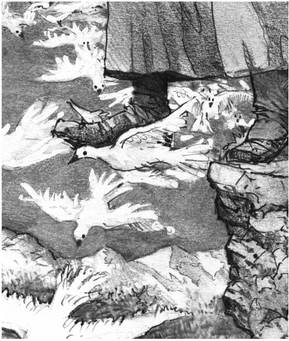|
Everyone is an artist, constantly exercising their craft, generating visions and molding the world accordingly. It's called coping, making do, dealing with it; those have always been the artist's basic tools.
The urban cathedrals of holy works enshrine reformers and thus neutralize them. Pretend-radicals are thrown in to confuse the truth of the matter. A madman here, a genius there, a poet, hipster, or sage gets snatched up by the box-keepers, displayed so we can see how the so-called artist escapes one box, only to end up in another to emboss the message “there are only boxes.” Then, true to the scientific method, these visionaries are smeared onto sample slides called museum walls for our viewing pleasure. They become figures in such cultured dioramas to help keep the ship of state move nicely by packaging their insights. Art?—well, it looks like a rectangular canvas under state of the art lighting, hanging inside a very nice box. If you want to understand it you have to learn about it, be a connoisseur. Ideally, artists should confound, entertain, disrupt, or amaze. The unspoken message is, “Don’t try this at home.” A visit to an art gallery gives me the impression artists are eccentrics, maybe even kooks like Richard Dreyfus, making a mountain of dirt in his living room in the movie Close Encounters. The well-funded forces that shape health, education, and welfare into manageable financial flows understand and suppress the truth that every man, woman and child is an artist. People have to create; period. It's a force of nature. And every force of nature is ultimately channeled through social turbines for obvious reasons of control and finance. Human beings are artists. They don't claim it, reclaim it, or discover it. The only way to take the art away from human beings is to fool them into thinking that art is in a museum, gallery, book, or notable commission. Read what's trending in the sidebar to find out the source material we are issued, the things that drive us to act and produce what we see around us. Our collective dreaming—the fabulous yarns that either freak-us-out or lull us into a stupor are all edited—approved and paid for by people we don’t know. Magazines, daily news, best selling novels and movies, are continuing education classesto make sure we know what should cause us to think and act, consciously or unconsciously. We fabricate our world based on images, stories, and horrors that continuously feed our psyches—because human beings are artists. Any individual could look at his or her hands and say, "I am an artist—but what is my vision?" And staring at the available tools: a box of crayons, broken nubs, or a lifetime—they could decide, "I will find out!" If a tiny percentage of theseven billion artists on earth practiced their art rather than someone else’s, the world would become beautiful, because people want to see beauty. They would have the intense, serious focus of children at play, longing for the unique vision, compelling and essential enough to inspire cooperative efforts. Eventually, for better or worse, they'd say. "It's done." The process would be constant. And the beauty humanity would come out. As it is, the works are created anonymously in secluded closets as lives-lived, children-raised, meals cooked, dogs walked, jobs-performed, each crafted anonymously by the artist.
5 Comments
1. Be present, (with your ability, tools, experience, materials, feelings)
2. Then Engage the task. Form a relationship with it, make it personal, invest yourself in it, be subjective rather than objective. 3. Learn the tools beginning with a pencil, then a pen, then the others (brush, marker, Adobe etc) 4. Keep your work but don't take it seriously. Move fast and lose too much caution on the front end. Realize the only piece of work is the one you accept as the end of the process, so overlay overlay overlay x a hundred. 5. Study precedent. Borrow from it, steal it, then throw it away. Pretend it was your idea. 6. Study the artistic process from a classical viewpoint. Masters, students, guilds, simple tasks, tracing, advancements, critique, craft, patience, the long haul. 7. Accept your idiosyncrasies. Let your flaws be part of your statement. You can't fix yourself. |
AuthorIn addition to art and architecture, Phil is an author of two books. Archives
October 2018
Categories |
Proudly powered by Weebly
